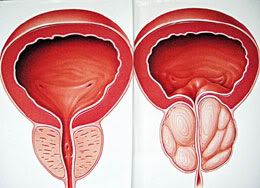Clinic of Complementary and Osteopathy Medicine
Osteopathic Treatment for Prostate Diseases
- Basics about the prostate (Anatomy)
- Prostate problems
- Prostatitis symptoms
- Prostate disease symptoms checklist
- How Osteopathic Treatment can help
Basics About the Prostate
 Often prostate described as a walnut or chestnut-shaped organ, the prostate is a gland that surrounds
the beginning of the urethra. The prostate produces a milky fluid that provides nutrient to the sperm
and is discharged into the urethra at the time of semen emission.
Often prostate described as a walnut or chestnut-shaped organ, the prostate is a gland that surrounds
the beginning of the urethra. The prostate produces a milky fluid that provides nutrient to the sperm
and is discharged into the urethra at the time of semen emission.
Prostate an organ exclusive to men, the development of the prostate is spurred by male hormones
(especially testosterone). The rate of prostate growth decreases and may stop around age 20.
A second growth period of prostate often occurs around age 45, as cells in the middle of the prostate
start to reproduce more rapidly than normal. This growth may result in
Benign Prostatic
Hyperplasia (BPH) or enlarged prostate.
Prostate Problems
 Detection of Prostate Problems
is tricky because of where the prostate is located. It is a bulb-shaped prostate that goes
round the urethra just where it leaves the bladder, so when it swells up urination becomes a problem.
Detection of Prostate Problems
is tricky because of where the prostate is located. It is a bulb-shaped prostate that goes
round the urethra just where it leaves the bladder, so when it swells up urination becomes a problem.
In fact, the first symptoms include finding it hard to urinate, wanting to urinate often, a burning
sensation when you do, or blood in the urine. But cases often aren't spotted until quite late because
the basic method of diagnosing an enlarged prostate is rectal examination for prostate problems and many
men prefer to avoid that.
Around 60 percent of men over the age of 45 have an enlarged prostate and prostate
problems with that.

Prostatitis Symptoms
Signs and symptoms may vary depending on the type of prostatitis you have.
Acute bacterial prostatitis
A sudden prostate's bacterial infection that is characterized by inflammation of the prostate.
Symptoms include:
• Increased urinary frequency and urgency during day and night
• Fever, chills, nausea and vomiting
• Pain in the lower abdomen, lower back, pelvis and genital area
• Blood in urine
• Pain with ejaculation
• Pain with bowel movement
• Pain or burning sensation when urinating
Chronic bacterial prostatitis
Chronic bacterial prostatitis may exist for several years without producing any symptoms.
When symptoms do appear, they are similar to acute bacterial prostatitis, but are less severe and
can fluctuate in intensity.
Symptoms Chronic bacterial prostatitis include:
• Frequent and urgent need to urinate
• Burning sensation or pain during urination
• Recurring bladder infections
• Periodic low-grade fever
Chronic nonbacterial prostatitis
Most common form of prostatitis (also called chronic pelvic pain syndrome). This type of prostatitis
is not caused by an infection (no bacteria detected in urine).
Symptoms Chronic nonbacterial prostatitis usually include:
• Urinary and genital area pain
• Burning sensation or pain during urination
• Painful ejaculation
• Diminished urine flow
 Osteopathic method of diagnosing an enlarged prostate is rectal examination
Osteopathic method of diagnosing an enlarged prostate is rectal examination

Prostate Disease Symptoms Checklist
- A need to urinate frequently, especially at night
- Difficulty starting urination or holding back urine
- Dribbling of urine
- Inability to urinate
- Feeling that the bladder is not empty after urination
- Weak or interrupted urine stream
- Pain or burning during urination
- Painful ejaculation
- Blood in urine or semen
- Frequent pain in the lower back, hips, or ribs
- Weight loss

Osteopathic treatment for Prostate diseases
Osteopathic treatment for Prostate diseases can be considered a genuine alternative to the conventional
treatment of chronic prostatitis and chronic pelvic pain syndrome, and a closer co-operation
between urologists/internists and osteopaths would be desirable.
Gynaecological or
prostate disorders can also be the root cause of your back pain.
Osteopathy is widely recognised for its success in treating patients with low back pain,
but may also be effective for patients with a variety of other symptoms/conditions including prostatitis.
The condition may benefit from osteopathic manipulative therapy as prostate disorders relate to
dysfunction of other parts of the body. The osteopathic technique for prostates problems may help
improve the lymph and blood drainage of the prostate area, and increase the circulation to the
prostate.

Finding out that you have a prostate disease can be difficult. It's important to talk with our Osteopathic Doctor about any questions or concerns you have.
More about Osteopathy
Importance of Healthy Spine
If you have disfunction in vertebral column you can have diseases. See the schema:
Misalignment of spinal vertebrae and assosiated possible conditions

 The
The  different treatments that are necessary components to achieve goals.
One of the important steps
is Colon Cleansing plan. Read more about
different treatments that are necessary components to achieve goals.
One of the important steps
is Colon Cleansing plan. Read more about